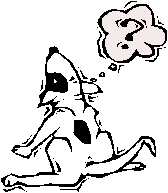|
A
Fairy Tale about Dog Behavior Gone
Wrong |
 Buddy was the cutest puppy they had
ever seen.
Buddy was the cutest puppy they had
ever seen.
He was curious and fun
loving, and the perfect buddy for
their three year old daughter, Julie.
The family wanted to do everything right
and follow everything their veterinarian
suggested. Since their veterinarian
didn't provide pet behavior counseling,
they just did what seemed natural.
Everyone
shared table scraps when Buddy asked for food.
After all, he was one of the family.
Whatever Buddy wanted, he got. He
rested on furniture, and slept
on their beds.
|
To keep Buddy safe, they kept him
isolated from other dogs and people.
To keep him entertained,
they gave him anything he
wanted as a toy. |
At four months of age, he began demanding
attention.
He would paw at their legs or
nudge with his nose, and the
petted and talked to him in
response. At about five
months old, if
he didn't want to be touched, they
respected his wishes. They thought
it was cute that he growled when anyone
went near his food dish. At about
six months old, they considered obedience
school, but never got around to it.
They resisted neutering Buddy after a friend
told them it might change his personality.
At five months, Mom tried to move Buddy off
the couch and he snapped at her.
She
figured Buddy’s feelings were
hurt, so she tried to soothe him. After that,
Buddy became increasingly short
tempered. No matter how much they petted
and reassured him, he still acted tense
and became more and more
disobedient. It seemed he was always
shaking his head, as if saying, “No, I won’t
do that.”
|
When he began urine marking
and destroying things, Buddy
became an outdoor dog. |
When Buddy was seven months old, he
bit a neighbor who came over for a
visit.
The family assumed the
neighbor did something to
deserve it. When Buddy attacked a friendly dog on a walk,
the family thought, “Buddy is just
that way.” They took him on
fewer walks after that.
One
day, when Buddy was eight months
old, Julie gave Buddy
a kiss.
She came toward him
face first while he was by his food dish. When the Doctor
told the family that Julie had permanent damage
to her face, they were shocked that
Buddy would “turn vicious.” That very day Buddy became history
and a bitter memory. Everyone in the
family was permanently scarred. They
began to warn everyone not to own
a dog because dogs are untrustworthy,
and can cause such heartache.
What went wrong with Buddy?
Puppy selection testing
might have shown a
genetic tendency toward
dominance aggression.
When Buddy
was young, he missed Puppy Socialization
and Training classes. Therefore,
he
didn't learn how to make friends with
other dogs and people when properly
introduced. He didn't learn manners
that would have allowed him to stay
indoors with his pack. Most importantly,
he didn't learn to think of all humans
as higher ranking pack members.
When Buddy
got anything
he wanted, he
assumed he could control everyone
and owned everything.
Then
he discovered that he could paw or
nudge anybody, anytime, and
control them to either touch or stop
touching him. He could demand food or
attention and the family gave it submissively.
They also unintentionally gave Buddy
the wrong message about his status
in the pack by
allowing him to sleep on the high
status places like on beds and
furniture. Buddy could go anywhere,
but could tell them to stay away from
certain areas. Male hormones further
encouraged Buddy to take charge of
the family.
Another early sign of future
aggression was
Buddy’s disobedience.
It seemed
each time Buddy displayed his status,
by ignoring their commands or growling,
they rewarded him by petting and talking
to him in soothing subordinate tones.
Buddy interpreted these responses as
praise which further reinforced his
aggressive behavior. When the big female
(Mom) tried to move
him from his favorite resting spot,
he put her in her place with a warning
snap. Soon Buddy thought he controlled
the world. He assumed both power and
position. Since the other dogs on the
walk and the neighbor didn't show
sufficient submissiveness to Buddy,
it was his job as higher ranking to put them
in their places. After all, Buddy was
put in charge by the big male and
female pack members.
From Buddy’s point of view,
attacking Julie was necessary to
control her actions.
When
the child tried to kiss Buddy, he
interpreted this close approach with
eye contact as a challenge to
ownership of the food and his dominant position in the pack.
Considering the previous messages
that he was given, it became
Buddy’s duty to take charge
and attack any
insubordinate challengers.
Buddy’s family had unintentionally
selected a dog with a predisposition
for dominance aggression. In
the litter, he was the one that
pushed other puppies away to run up
and jump all over them. After
selecting him as the "friendliest"
and one that "choose them", with
all the best intentions, the family unwittingly
molded Buddy so he would predictably
attack dogs, adults, and children.
The only reason this story
is not more common is that dominance tendencies
have been bred out of most non-guard
dogs.
Separate from the emotional pain,
how the legal liability of aggression
can financially destroy a family.
The veterinarian’s role could
have included pet selection counseling,
puppy classes, daycare, neutering,
and prescribing a head halter. Veterinary
visits
could have provided behavioral information
on how to decrease aggression by maintaining
positive leadership, and ruling out
any medical contributions to
aggression (such as the irritation of an
unidentified chronic
ear, tooth, or other infection). At the very least
the DVM could have asked the client
during the exam visit, "Any concerns
about Buddy's behavior?" and then referred the case
to a qualified animal behavior
consultant.
Meet
Rolan Tripp, DVM